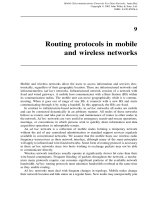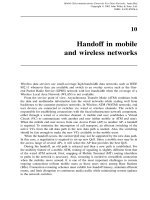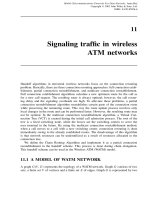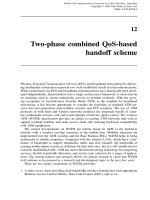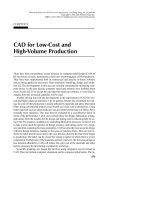Tài liệu DAV Nguyên tắc và các ứng dụng P10 ppt
Bạn đang xem bản rút gọn của tài liệu. Xem và tải ngay bản đầy đủ của tài liệu tại đây (124.9 KB, 16 trang )
10
Handoff in mobile
and wireless networks
Wireless data services use small-coverage high-bandwidth data networks such as IEEE
802.11 whenever they are available and switch to an overlay service such as the Gen-
eral Packet Radio Service (GPRS) network with low bandwidth when the coverage of a
Wireless Local Area Network (WLAN) is not available.
From the service point of view, Asynchronous Transfer Mode (ATM) combines both
the data and multimedia information into the wired networks while scaling well from
backbones to the customer premises networks. In Wireless ATM (WATM) networks, end
user devices are connected to switches via wired or wireless channels. The switch is
responsible for establishing connections with the fixed infrastructure network component,
either through a wired or a wireless channel. A mobile end user establishes a Virtual
Circuit (VC) to communicate with another end user (either mobile or ATM end user).
When the mobile end user moves from one Access Point (AP) to another AP, a handoff
is required. To minimize the interruption of cell transport, an efficient switching of the
active VCs from the old data path to the new data path is needed. Also, the switching
should be fast enough to make the new VCs available to the mobile users.
When the handoff occurs, the current QoS may not be supported by the new data path.
In this case, a negotiation is required to set up new QoS. Since a mobile user may be in
the access range of several APs, it will select the AP that provides the best QoS.
During the handoff, an old path is released and then a new path is established. For
the mobility feature of a mobile ATM, routing of signaling is slightly different from that
of the wired ATM network. First, mapping of Mobile Terminal (MT) routing identifiers
to paths in the network is necessary. Also, rerouting is needed to reestablish connection
when the mobiles move around. It is one of the most important challenges to reroute
ongoing connections to/from mobile users as those users move among Base Stations
(BSs). Connection rerouting schemes must exhibit low handoff latency, maintain efficient
routes, and limit disruption to continuous media traffic while minimizing reroute updates
to the network switches.
Mobile Telecommunications Protocols For Data Networks. Anna Ha
´
c
Copyright
2003 John Wiley & Sons, Ltd.
ISBN: 0-470-85056-6
182
HANDOFF IN MOBILE AND WIRELESS NETWORKS
Limiting handoff latency is essential, particularly in microcellular networks where
handoffs may occur frequently and users may suddenly lose contact with the previous
wireless AP. To reduce the signaling traffic and to maintain an efficient route may lead
to disruptions in service to the user that is intolerable for continuous media applications
such as packetized audio and video. Thus, it is important to achieve a suitable trade-off
between the goals of reducing signaling traffic, maintaining an efficient route, and limiting
disruption to continuous media traffic, while at the same time maintaining low handoff
latency. Connection rerouting procedures for ATM-based wireless networks have been
proposed for performing connection rerouting during handoff.
Break-Make and Make-Break schemes are categorized as optimistic schemes because
their goals are to perform simple and fast handoff with the optimistic view that disruption
to user traffic will be minimal. The Crossover Switch (COS) simply reroutes data traffic
through a different path to the new BS, with the connection from the source to the COS
remaining unmodified. In the make-break scheme, a new translation table entry in the
ATM switch (make) is created and later the old translation entry (break) is removed. This
results in cells being multicast from the COS to both the new and the old BSs for a short
period of time during the handoff process.
The key idea of Predictive Approaches is to predict the next BS of the mobile end-
point and perform advance multicasting of data to the BS. This approach requires the
maintenance of multiple connection paths to many or all the neighbors of the current BS
of the mobile endpoint.
The basic idea of chaining approaches to connection rerouting is to extend the con-
nection from the old to the new BS in the form of a chain. Chaining results in increased
end-to-end delay and less efficient routing of the connection.
Chaining, followed by the make-break scheme, which involved a real-time handoff
using the chaining scheme and, if necessary, a non-real-time rerouting using the make-
break scheme, shows good performance in connection rerouting, because the separation
of the real-time nature of handoffs and efficient route identification in this scheme allows
it to perform handoffs quickly, and, at the same time, maintains efficient routes in the
fixed part of the network.
The main development in shaping up the future high-speed (gigabit) networking is
the emergence of Broadband ISDN (B-ISDN) and ATM. With its cell switching and
the support of Virtual Path (VP) and Virtual Circuit (VC), ATM can provide a wide
variety of traffic and diverse services, including real-time multimedia (data, voice, and
video) applications. Because of its efficiency and flexibility, ATM is considered the most
promising transfer technique for the implementation of B-ISDN, and for the future of
high-speed wide and local area networks.
Handoff is important in any mobile network because of the default cellular architecture
employed to maximize spectrum utilization. When a Mobile Terminal moves away from
a BS, the signal level degrades, and there is a need to switch communications to another
BS. Handoff is the mechanism by which an ongoing connection between an MT or host
(MH) and a correspondent terminal or host (CH) is transferred from one point of access to
the fixed network, and to another. In cellular voice telephony and mobile data networks,
such points of attachment are referred to as base stations and in WLANs they are called
access points. In either case, such a point of attachment serves a coverage area called
HANDOFF IN MOBILE AND WIRELESS NETWORKS
183
a cell. Handoff, in the case of cellular telephony, involves the transfer of voice call
from one BS to another. In the case of WLANs, it involves transferring the connection
from one AP to another. In hybrid networks, it will involve the transfer of a connection
from one BS to another, from an AP to another, between a BS and an AP, or vice versa.
WATM networks are typically inter-networked with a wired network (an ATM net-
work) that provides wired connectivity among BSs in the wireless network, as well as
connectivity to other fixed endpoints. In Figure 10.1, the service area in a wireless net-
work is partitioned into cells. A cell is the region that receives its wireless coverage from
a single BS. In a typical scenario, the coverage of the cells overlaps and the BSs are
connected to each other and to fixed endpoints (e.g., hosts) through a wired ATM-based
backbone network. A route connects a mobile device to a fixed endpoint.
In Figure 10.1, the Control and Switching Unit (CSU) provides mobility-related sig-
naling (registration, deregistration, location update, and handoff), as well as routing of
ATM cells. It is assumed that the CSU incorporates a typical commercially available ATM
switch. The operation of the CSU is supported by a specially designed database (DB).
For a voice user, handoff results in an audible click interrupting the conversation
for each handoff, and because of handoff, data users may lose packets and unnecessary
congestion control measures may degrade the signal level; however, it is a random process,
and simple decision mechanisms such as those based on signal strength measurements
result in the ping-pong effect. The ping-pong effect refers to several handoffs that occur
back and forth between two BSs. This takes a severe toll on both the user’s quality
perception and the network load. One way of eliminating the ping-pong effect is to
persist with a BS for as long as possible. However, if handoff is delayed, weak signal
reception persists unnecessarily, resulting in lower voice quality, increasing the probability
of call drops and/or degradation of quality of service (QoS). Consequently, more complex
algorithms are needed to decide on the optimal time for handoff.
While significant work has been done on handoff mechanisms in circuit-switched mobile
networks, there is not much literature available on packet-switched mobile networks.
MT
BS
BS
Fixed ATM
Fixed ATM
infrastructure
DB
CSU
Figure 10.1 Configuration of WATM network.
184
HANDOFF IN MOBILE AND WIRELESS NETWORKS
Performance measures such as call blocking and call dropping are applicable only to
real-time traffic and may not be suitable for the bursty traffic that exists in client-server
applications. When a voice call is in progress, allowed latency is very limited, resource
allocation has to be guaranteed, and, while occasionally some packets may be dropped and
moderate error rates are permissible, retransmissions are not possible, and connectivity has
to be maintained continuously. On the other hand, bursty data traffic by definition needs
only intermittent connectivity, and it can tolerate greater latencies and employ retransmis-
sion of lost packets. In such networks, handoff is warranted only when the terminal moves
out of coverage of the current point of attachment, or the traffic load is so high that a
handoff may result in greater throughput and utilization.
10.1 SIGNALING HANDOFF PROTOCOL IN WATM
NETWORKS
Signaling is a problem area in WATM networks. Apart from the conventional signal-
ing solutions encountered in wired networks, additional signaling is needed to cover the
mobility requirements of terminals. Wired ATM networks, which are enjoying commer-
cial growth, do not support mobility of user terminal equipment. A possible solution
to this problem is the integration of the required mobility extensions with the standard
signaling protocols.
Protocol stacks in WATM are shown in Figure 10.2. This protocol includes mobility
function for handoff. In Figure 10.2, we have the following components:
• MMC : Mobility Management and Control
• RRM : Radio Resource Manager
• SAAL: Signaling ATM Adaptation Layer
• CCS : Call Control and Signaling
• UNI : User-Network Interface
U-plane
SAAL
AT M
WMAC
CCS
UNI3.1
MT_MMC
PHY
Mobile terminal
Radio
link
Base station
RRM
AT M
AT M
PHY
PHY
WMAC
PHY
SAAL
RM
NNI
CS_MMC
Q2931
Control switching unit
DB
Figure 10.2 Protocol stacks.
CROSSOVER SWITCH DISCOVERY
185
• WMAC : Wireless Medium Access Control
• S-channels: Permanent Virtual Circuits (PVCs) intended for standard signal
• M-channels: PVCs intended for mobility signaling
• U-plane:Userplane.
In Figure 10.2, the standard signaling is left unaffected. To support mobility functions,
the only modifications added to the existing infrastructure are the new interfaces with
the controlling entities of standard signaling (i.e., CCS, resource manager). In terms of
module-entity instances, there is a one-to-one mapping between the RRM and the BSs
(each BS has an RRM instance). There is also a one-to-one relationship between active
MTs and MMC instances residing within the MMC in the CCS entity. In each MT, only
one MMC and one CCS instance are needed.
The CS
MMC module is responsible for handling all mobility-related procedures (i.e.,
handover, registration, and location update) on the network side. Specifically, the CS
MMC
deals with the following tasks:
• the establishment of the M-channel through which the mobility-related messages are
exchanged;
• the coordination of wireless and fixed resources, during the execution of mobility and
standard signaling procedures;
• the switching of signaling and data connections whenever an MT crosses the boundaries
of a cell;
• the updating of the location of an MT in the CSU-hosted DB.
The basic steps involved in handoff occur in an application scenario, involving Mobile
Multi-User Platforms (MMUPs) equipped with (onboard) private ATM networks.
Connection handoff is the procedure of rerouting an existing connection from the
previous AP to the next when a mobile moves across a cell boundary. Success rate of
handoffs and their smooth completion are crucial to providing satisfactory quality of
service to mobile users. A handoff is successful if the connection is reestablished with
the MMUP in the new cell. A handoff is smooth if the connection suffers no or minimum
perceivable disruption during the transfer. Smoothness of handoffs depends on the number
of connections requiring handoff, and the time between initiation of a handoff and loss of
contact with the previous AP. MMUPs can have a large number of connections existing
simultaneously owing to the presence of multiple users onboard, and a short time period
available for handoffs because of high travel speeds.
10.2 CROSSOVER SWITCH DISCOVERY
The basic step common to most handoff schemes for mobile ATM networks is crossover
switch discovery for each connection that required a handoff. A crossover switch (COS)
is an intermediate switch along the current path of a connection that has nonoverlapping
paths to both the current and the next APs. The process of selecting a COS for a connection
can be initiated at the previous or next AP. Once a particular COS is selected, appropriate
resources for the connection are procured along the new subpath (between the COS
186
HANDOFF IN MOBILE AND WIRELESS NETWORKS
Unchanged path
Existing subpath
S4
COS
S2
S1
S3
AP2 AP1
MMUP
New subpath
S 1−4 : Cellular network switches
COS : Cross-over switch
AP 1−2 : Access points
Figure 10.3 Crossover switch–based connection rerouting during handoff.
and the new AP). After the COS starts forwarding packets onto the new subpath, the
existing subpath to the previous AP is torn down, thereby completing the handoff of
that connection. Figure 10.3 shows an example of COS rerouting of a connection during
handoff. S2 is the COS to be found during the handoff process. In Figure 10.3, we have
• S1, S2, S3, and S4, which are the cellular network switches
• COS, which is the crossover switch
• AP1, and AP2, which are the access points.
The selection of a particular switch as a COS for a connection depends on several
factors, including
• switch capability
• selection policy




